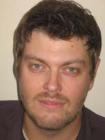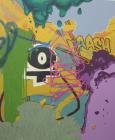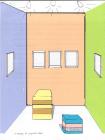1
Pete Smith, the eldest of two children, was born in 1975 in North Bay, Ontario, as Peter Allan Smith. He was raised in North Bay.He moved to Toronto, Ontario in 1994, where he earned a Bachelor of Fine Arts from York University from 1994 to 1998. In 2000, he returned to North Bay, to do a one-year Bachelor of Education at Nipissing University in 2001. He returned to Toronto in 2000. In 1999, he was curator of The Launch Pad Gallery. Since 2005, when he began a Masters of Fine Art in Studio Visual Art in painting at the University of Guelph, he has resided in both Guelph and Toronto. His graduate advisor is John Kissick with Will Gorlitz and Monica Tap serving as co-advisors. He received a University of Guelph Graduate Scholarship and Tony Sherman Graduate Painting Scholarship from the University of Guelph in 2005.
Solo exhibitions include Achilles Heel (2005, Joan Ferneyhough Gallery, North Bay, Ontario), Extraterrestrial (2003, Red Head Gallery, Toronto, Ontario), Out of this airless sky (2003, White Water Gallery, North Bay, Ontario), hero biscuits (2002, 1080 BUS Gallery, Toronto, Ontario), hansel and gretel (2000, The Art Firm, Toronto, Ontario), diary (2000, Angell Gallery, Toronto, Ontario), broken animals (2000, White Water Gallery, Ontario), in the moor (1999, The Art Firm, Toronto, Ontario), and transitions (1998, The LAUNCH PAD Gallery, Toronto, Ontario).
He received an Emerging Artist Grant in 2003 from the Ontario Arts Council and an Exhibition Assistance Grant in 2000 from the Ontario Arts Council.
In 2001, he married Stacey Wraxall, with whom he has a child.
He is represented by Elissa Cristall Gallery in Vancouver, British Columbia; Joan Ferneyhough Gallery in North Bay, Ontario; and his collaborative work with Otino Corsano is exclusively represented by Katherine Mulherin in Toronto, Ontario.
(The biographical information featured here was written in consultation with the artist in 2006.)
Interview:
Q: What is your earliest memory of creating art?
A: As a kid I had a little drawing table that I would sit at for hours. My parents still have the little table in their house. When other kids were out playing road hockey, I'd be at that table drawing. (Although I did play a bit of road hockey also.)
Q: When did you first feel like an artist?
A: I don't remember ever not feeling like an artist. It's something I've always been, which isn't to say that it's something that I've always wanted to be. It's something you just sort of are or aren't. Being an artist is a tough gig. If it's something that exists as a choice for you then it's something you'll probably stop doing at some point. Very few people from my undergrad remain as working artists.
Q: Tell me about the work your doing in your MFA. Can you describe your creative process?
A: The basic idea for my recent work was to make 'abstract-like' paintings wherein none of the individual gestures would be of my own invention. I spent the summer collecting images, digital photos of tags, graphics, spills, etc, things that create the visual noise that bombards our every day. Then I would trace the forms, project them and layer them. The idea was to remix the everyday and to create a collision of graphic and painterly conventions. They're acrylic on canvas. Or more formally (as in the thesis statement
from my thesis):
My work is encyclopedic and post-historical. It translates, remixes and hybridizes various aspects of the social landscape into a personalized, material response.
Q: Can you tell me about your collaborative work with Otino Corsano?
A: Otino Corsano was somebody that I met while I was a member at the Red Head Gallery. We had a lot of common ideas about art and we'd talked about maybe doing something together. The whole thing came about quite accidentally. In the spring of 2003 I had a bit of a dilemma in that I had committed to showing at Katherine Mulherin in the summer and then also to the Red Head later in the fall. I realized that I wouldn't be able to do both with any degree of competency, so I asked Katherine if I could do a show of collaborations. I think that she probably didn't have enough time left to ask anybody else, so she let us do it. The show was a pretty big hit. It sold out at the opening and Gary Michael Dault wrote a pretty nice piece about it. It attracted some pretty solid curatorial and collector interest. We've done a few more things since that have also been pretty well received. It was really only meant to be a one-off thing, but it went so well and we had a lot of fun, so we've kept doing it. That said, we haven't done a whole lot together since I've been back in school, but we plan to down the road.
Q: How would you say your work has changed over time?
A: My work has changed a lot over the years and I hope that it keeps changing. I think that the model of an artist doing the same thing for thirty years is really old and boring. I think that the newer model, which would be foreshadowed by artists like Gerhard Richter or Brice Marden, shows an art practice to be a more fluid engagement with subject. A retrospective of either artist looks almost like a group show. This tendency becomes quite extravagantly exaggerated in the work of some younger artists like Laura Owens.
(Interview with Heather Saunders in December, 2006).


